|
1 - The Host of Heaven
In the beginning
God created the Heaven and the Earth.
The very concept of a beginning of all things is basic to modern
astronomy and astrophysics. The statement that there was a void and
chaos before there was order conforms to the very latest theories
that chaos, not permanent stability, rules the universe. And then
there is the statement about the bolt of light that began the
process of creation.
Was this a reference to the Big Bang, the theory according to which
the universe was created from a primordial explosion, a burst of
energy in the form of light, that sent the matter from which stars
and planets and rocks and human beings are formed flying in all
directions and creating the wonders we see in the heavens and on
Earth? Some scientists, inspired by the insights of our most
inspiring source, have thought so. But then, how did ancient Man
know the Big Bang theory so long ago? Or was this biblical tale the
description of matters closer to home, of how our own little planet
Earth and the heavenly zone called the Firmament, or “hammered-out
bracelet,” were formed? Indeed, how did ancient Man come to have a
cosmogony at all? How much did he really know, and how did he know
it?
It is only appropriate that we begin the quest for answers
where the events began to unfold—in the heavens; where also,
from time immemorial, Man has felt that his origins, higher
values—God, if you will—are to be found. As thrilling as
discoveries made by the use of microscopes are, it is what
telescopes enable us to see that fills us with the realization of
the grandeur of nature and the universe. Of all recent advances,
the most impressive have undoubtedly been the discoveries in the
heavens surrounding our planet.
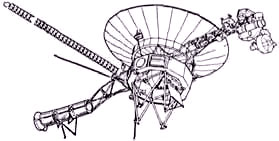
Figure 1
And what staggering advances they have been! In a mere few decades we Earthlings have
soared off the face of our planet; roamed Earth’s skies hundreds of
miles above its surface; landed on its solitary satellite, the Moon;
and sent an array of unmanned spacecraft to probe our celestial
neighbors, discovering vibrant and active worlds dazzling in their
colors, features, makeup, satellites, rings. For the first time,
perhaps, we can grasp the meaning and feel the scope of the
Psalmist’s words:
The heavens bespeak the glory of the Lord and the vault of heaven
reveals His handiwork.
A fantastic era of planetary exploration came to a magnificent
climax when, in August 1989, the unmanned spacecraft designated
Voyager 2 flew by distant Neptune and sent back to Earth pictures
and other data. Weighing just about a ton but ingeniously packed
with television cameras, sensing and measuring equipment, a power
source based on nuclear decay, transmitting antennas, and tiny
computers (Fig. 1), it sent back whisper-like pulses that required
more than four hours to reach Earth even at the speed of light.
On
Earth the pulses were captured by an array of radiotelescopes that
form the Deep Space Network of the U.S. National Aeronautics and
Space Administration (NASA); then the faint signals were translated
by electronic wizardry into photographs, charts, and other forms of
data at the sophisticated facilities of the Jet Propulsion The Host
of Heaven 5 Laboratory (JPL) in Pasadena, California, which managed
the project for NASA.
Launched in August 1977, twelve years before this final mission—the
visit to Neptune—was accomplished. Voyager 2 and its companion.
Voyager I, were originally intended to reach and scan only Jupiter
and Saturn and augment data obtained earlier about those two gaseous
giants by the Pioneer 10 and Pioneer 11 unmanned spacecraft. But
with remarkable ingenuity and skill, the JPL scientists and
technicians took advantage of a rare alignment of the outer planets
and, using the gravitational forces of these planets as
“slingshots,” managed to thrust Voyager 2 first from Saturn to
Uranus and then from Uranus to Neptune (Fig. 2).
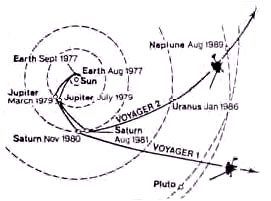
Figure 2
Thus it was that for several days at the end of August 1989,
headlines concerning another world pushed aside the usual news of
armed conflicts, political upheavals, sports results, and market
reports that make up Mankind’s daily fare. For a few days the world
we call Earth took time out to watch another world; we, Earthlings,
were glued to our television sets, thrilled by close-up pictures of
another planet, the one we call Neptune.
As the dazzling images of an aquamarine globe appeared on our
television screens, the commentators stressed repeatedly that this
was the first time that Man on Earth had ever really been able to
see this planet, which even with the best Earth-based telescopes is
visible only as a dimly lit spot in the darkness of space almost
three billion miles from us. They reminded the viewers that Neptune
was discovered only in 1846, after perturbations in the orbit of the
somewhat nearer planet Uranus indicated the existence of another
celestial body beyond it.
They reminded us that no one before
that—neither Sir Isaac Newton nor Johannes Kepler, who between them
discovered and laid down the laws of celestial motion in the
seventeenth and eighteenth centuries; neither Copernicus, who in the
sixteenth century determined that the Sun, not the Earth, was in the
center of our planetary system, nor Galileo, who a century later
used a telescope to announce that Jupiter had four moons—no great
astronomer until the mid-nineteenth century and certainly no one in
earlier times knew of Neptune. And thus not only the average TV
viewer but the astronomers themselves were about to see what had
been unseen before—it would be the first time we would learn the
true hues and makeup of Neptune.
But two months before the August encounter, I had written an article
for a number of U. S., European, and South American monthlies
contradicting these long-held notions: Neptune was known in
antiquity, I wrote; and the discoveries that were about to be made
would only confirm ancient knowledge. Neptune, I predicted, would be
blue-green, watery, and have patches the color of “swamplike
vegetation”!
The electronic signals from Voyager 2 confirmed all that and more.
They revealed a beautiful blue-green, aquamarine planet embraced by
an atmosphere of helium, hydrogen, and methane gases, swept by
swirling, high-velocity winds that make Earth’s hurricanes look
timid. Below this atmosphere there appear mysterious giant “smudges”
whose coloration is sometimes darker blue and sometimes greenish
yellow, perhaps depending on the angle at which sunlight strikes
them. As expected, the atmospheric and surface temperatures are
below freezing, but unexpectedly Neptune was found to emit heat that
emanates from within the planet.
Contrary to the previous The Host
of Heaven 7 consideration of Neptune as being a “gaseous” planet, it
was determined by Voyager 2 to have a rocky core above which there
floats, in the words of the JPL scientists, “a slurry mixture of
water ice.” This watery layer, circling the rocky core as the planet
revolves in its sixteen-hour day, acts as a dynamo that creates a
sizable magnetic field.
This beautiful planet (below image) was found to be
encircled by several rings made up of boulders, rocks, and dust and
is orbited by at least eight satellites, or moons. Of the latter,
the largest, Triton, proved no less spectacular than its planetary
master.
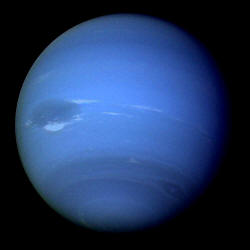
Voyager 2 confirmed the retrograde motion of this small
celestial body (almost the size of Earth’s Moon): it orbits Neptune
in a direction opposite to that of the coursing of Neptune and all
other known planets in our Solar System, not anticlockwise as they
do but clockwise. Besides its very existence, its approximate size,
and its retrograde motion, astronomers knew nothing else of Triton.
Voyager 2 revealed it to be a “blue moon,” an appearance resulting
from methane in Triton’s atmosphere.
The surface of Triton showed
through the thin atmosphere—a pinkish gray surface with rugged,
mountainous features on one side and smooth, almost craterless
features on the other side. Close-up pictures suggested recent
volcanic activity but of a very odd kind: what the active, hot
interior of this celestial body spews out is not molten lava but
jets of slushy ice. Even preliminary assessments indicated that
Triton had flowing water in its past, quite possibly even lakes that
may have existed on the surface until relatively recent times, in
geological terms.
The astronomers had no immediate explanation for
“double-tracked ridge lines” that run straight for hundreds of miles
and, at one or even two points, intersect at what appears to be
right angles, suggesting rectangular areas (Fig. 3).
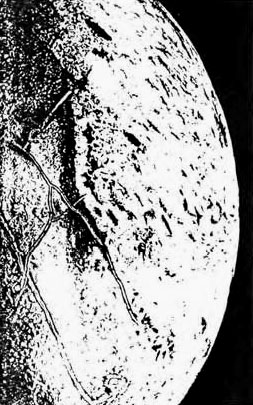
Fig. 3
The discoveries thus fully confirmed my prediction:
-
Neptune
is indeed blue-green
-
it is made up in great part of water
-
it does have patches whose coloration looks like “swamp-like
vegetation”
This last tantalizing aspect may bespeak more
than a color code if the full implication of the discoveries on
Triton is taken into consideration: there, “darker patches with
brighter halos” have suggested to the scientists of NASA the
existence
of “deep pools of organic sludge.” Bob Davis reported from Pasadena to
The Wall Street Journal that Triton, whose
atmosphere contains as much nitrogen as Earth’s, may be spewing out
from its active volcanoes not only gases and water ice but also
‘”organic material, carbon-based compounds which apparently coat
parts of Triton.”
Such gratifying and overwhelming corroboration of my prediction was
not the result of a mere lucky guess. It goes back to 1976 when
The
12th Planet, my first book in The Earth Chronicles series, was
published. Basing my conclusions on millennia-old Sumerian texts, I
had asked rhetorically:
“When we probe Neptune someday, will we
discover that its persistent association with waters is due to the
watery swamps” that had once been seen there?
This was published, and obviously written, a year before Voyager 2
was even launched and was restated by me in an article two months
before the Neptune encounter. How could I be so sure, on the eve of
Voyager’s encounter with Neptune, that my 1976 prediction would be
corroborated—how dared I take the chance that my predictions would
be disproved within weeks after submitting my article? My certainty
was based on what happened in January 1986, when Voyager 2 flew by
the planet Uranus.
Although somewhat closer to us—Uranus is “only” about two billion
miles away—it lies so far beyond Saturn that it cannot be seen from
Earth with the naked eye. It was discovered in 1781 by Frederick
Wilhelm Herschel, a musician turned amateur astronomer, only after
the telescope was perfected. At the time of its discovery and to
this day, Uranus has been hailed as the first planet we known in
antiquity to be discovered in modern times; for, it has been held,
the ancient peoples knew of and venerated the Sun, the Moon, and
only five planets (Mercury, Venus, Mars, Jupiter, and Saturn), which
they believed moved around the Earth in the “vault of heaven”;
nothing could be seen or known beyond Saturn.
But the very evidence gathered by Voyager 2 at Uranus proved the
opposite: that at one time a certain ancient people did know about
Uranus, and about Neptune, and even about the more-distant
Pluto!
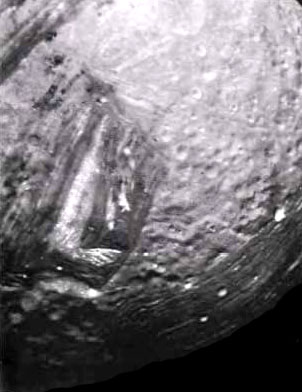
Plate A
Scientists are still analyzing the photographs and data from
Uranus and its amazing moons, seeking answers to endless
puzzles. Why does Uranus lie on its side, as though it was hit by
another large celestial object in a collision? Why do its winds blow
in a retrograde direction, contrary to what is normal in the Solar
System? Why is its temperature on the side that is hidden from the
Sun the same as on the side facing the Sun?
And what shaped the unusual features and formations on some
of the Uranian moons? Especially intriguing is the moon called
Miranda, “one of the most enigmatic objects in the Solar System,” in the words of
NASA’s astronomers, where an elevated,
flattened-out plateau is delineated by 100-mile-long escarpments
that form a right angle (a feature nicknamed “the Chevron” by the
astronomers), and where, on both sides of this plateau, there appear
elliptical features that look like racetracks ploughed over by
concentric furrows (Plate A and Fig. 4).
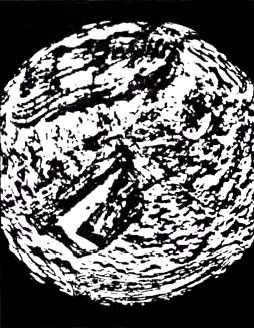
Figure 4
Two phenomena, however,
stand out as the major discoveries regarding Uranus, distinguishing
it from other planets. One is its color. With the aid of Earth-based
telescopes and unmanned spacecraft we have become familiar with the graybrown of Mercury, the sulphur-colored haze that envelops Venus,
the reddish Mars, the multihued red-brown-yellow Jupiter and Saturn.
But as the breathtaking images of Uranus began to appear on television screens in January 1986, its most striking
feature was its greenish blue color—a color totally different from
that of all the previous planets seen (see Uranus below).
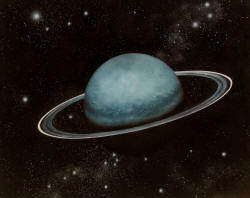
The other different and unexpected finding had to do with what
Uranus is made of. Defying earlier assumptions by astronomers that
Uranus is a totally “gaseous” planet like the giants Jupiter and
Saturn, it was found by Voyager 2 to be covered not by gases but by
water; not just a sheet of frozen ice on its surface but an ocean of
water. A gaseous atmosphere, it was found, indeed enshrouds the
planet; but below it there churns an immense layer—6,000 miles
thick!—of “super-heated water, its temperature as high as 8,000
degrees Fahrenheit” (in the words of JPL analysts). This layer of
liquid, hot water surrounds a molten rocky core where radioactive
elements (or other, unknown processes) produce the immense internal
heat.
As the images of Uranus grew bigger on the TV screen the closer
Voyager 2 neared the planet, the moderator at the Jet Propulsion
Laboratory drew attention to its unusual green-blue color. I could
not help cry out loud,
"Oh, my God, it is exactly as the Sumerians
had described it!”
I hurried to my study, picked up a copy of The
12th Planet, and with unsteady hands looked up page 269 (in the Avon
paperback edition). I read again and again the lines quoting the
ancient texts. Yes, there was no doubt: though they had no
telescopes, the Sumerians had described Uranus as MASH.SIG, a term
which I had translated “bright greenish.”
A few days later came the results of the analysis of Voyager 2’s
data, and the Sumerian reference to water on Uranus was also
corroborated. Indeed, there appeared to be water all over the place:
as reported on a wrap-up program on the television series NOVA (‘The
Planet That Got Knocked on Its Side”), “Voyager 2 found that all the
moons of Uranus are made up of rock and ordinary water ice”. This
abundance, or even the mere presence, of water on the supposed
“gaseous” planets and their satellites at the edges of the Solar
System was totally unexpected.
Yet here we had the evidence, presented in The 12th Planet, that in
their texts from millennia ago the ancient Sumerians had not only
known of the existence of Uranus but had accurately described it as
greenish blue and watery!
What did all that mean? It meant that in 1986 modern science did not
discover what had been unknown; rather, it rediscovered and caught
up with ancient knowledge. It was, therefore, because of that 1986
corroboration of my 1976 writings and thus of the veracity of the
Sumerian texts that I felt confident enough to predict, on the eve
of the Voyager 2 encounter with Neptune, what it would discover
there.
The Voyager 2 flybys of Uranus and Neptune had thus confirmed not
only ancient knowledge regarding the very existence of these two
outer planets but also crucial details regarding them. The 1989
flyby of Neptune provided still more corroboration of the ancient
texts. In them, Neptune was listed before Uranus, as would be
expected of someone who is coming into the Solar System and sees
first Pluto, then Neptune, and then Uranus. In these texts or
planetary lists Uranus was called Kakkab shanamma, “Planet Which Is
the Double” of Neptune.
The Voyager 2 data goes far to uphold this
ancient notion. Uranus is indeed a look-alike of Neptune in size,
color, and watery content; both planets are encircled by rings and
orbited by a multitude of satellites, or moons. An unexpected
similarity has been found regarding the two planets’ magnetic
fields: both have an unusually extreme inclination relative to the
planets’ axes of rotation—58 degrees on Uranus, 50 degrees on
Neptune.
“Neptune appears to be almost a magnetic twin of Uranus,”
John Noble Wilford reported in The New York Times.
The two planets are also similar in the lengths of their days: each about sixteen to seventeen hours long. The ferocious winds on
Neptune and the water ice slurry layer on its surface attest to the
great internal heat it generates, like that of Uranus. In fact, the
reports from JPL state that initial temperature readings indicated
that,
“Neptune’s temperatures are similar to those of Uranus, which
is more than a billion miles closer to the Sun.”
Therefore, the
scientists assumed “that Neptune somehow is generating more of its
internal heat than Uranus does”—somehow compensating for its greater
distance from the Sun to attain the same temperatures as Uranus
generates, resulting in similar temperatures on both planets—and
thus adding one more feature “to the size and other characteristics
that make Uranus a near twin of Neptune.”
“Planet which is the
double,” the Sumerians said of Uranus in comparing it to Neptune.
“Size and other characteristics that make
Uranus a near twin of Neptune,” NASA’s scientists announced. Not
only the described characteristics but even the terminology—“planet
which is the double,” “a near twin of Neptune”—is similar. But one
statement, the Sumerian one, was made circa 4,000 B.C., and the
other, by NASA, in AD. 1989, nearly 6,000 years later. . . .
In the case of these two distant planets, it seems that modern
science has only caught up with ancient knowledge. It sounds
incredible, but the facts ought to speak for themselves. Moreover,
this is just the first of a series of scientific discoveries in the
years since The 12th Planet was published that corroborate its
findings in one instance after another.
Those who have read my books (The Stairway to Heaven,
The Wars of
Gods and Men, and
The Lost Realms followed the first one) know that
they are based, first and foremost, on the knowledge bequeathed to
us by the Sumerians. Theirs was the first known civilization.
Appearing suddenly and seemingly out of nowhere some 6,000 years
ago, it is credited with virtually all the “firsts” of a high
civilization: inventions and innovations, concepts and beliefs,
which form the foundation of our own Western culture and indeed of
all other civilizations and cultures throughout the Earth. The wheel
and animal-drawn vehicles, boats for rivers and ships for seas, the
kiln and the brick, high-rise buildings, writing and schools and
scribes, laws and judges and juries, kingship and citizens’
councils, music and dance and art, medicine and chemistry, weaving
and textiles, religion and priesthoods and temples—they all began
there, in Sumer, a country in the southern part of today’s Iraq,
located in ancient Mesopotamia.
Above all, knowledge of mathematics
and astronomy began there. Indeed, all the basic elements of modern
astronomy are of Sumerian origin: the concept of a celestial sphere,
of a horizon and a zenith, of the circle’s division into 360
degrees, of a celestial band in which the planets orbit the Sun, of
grouping stars into constellations and giving them the names and
pictorial images that we call the zodiac, of applying the number 12
to this zodiac and to the divisions of time, and of devising a
calendar that has been the basis of calendars to this very day. All
that and much, much more began in Sumer.
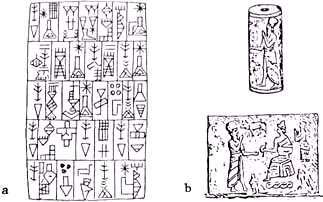
Figure 5
The Sumerians recorded their commercial and legal transactions,
their tales and their histories, on clay tablets (Fig. 5a); they
drew their illustrations on cylinder seals on which the depiction
was carved in reverse, as a negative, that appeared as a positive
when the seal was rolled on wet clay (Fig. 5b). In the ruins of
Sumerian cities excavated by archaeologists in the past century and
a half, hundreds, if not thousands, of the texts and illustrations
that were found dealt with astronomy. Among them are lists of stars
and constellations in their correct heavenly locations and manuals
for observing the rising and setting of stars and planets.
There are
texts specifically dealing with the Solar System. There are texts
among the unearthed tablets that list the planets orbiting the Sun
in their correct order; one text even gives the distances between
the planets. And there are illustrations on cylinder seals depicting
the Solar System, as the one shown in Plate B that is at least 4,500
years old and that is now kept in the Near Eastern Section of the
State Museum in East Berlin, catalogued under number VA/243.
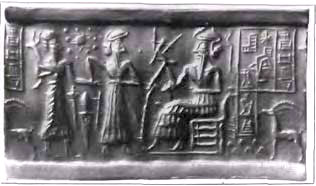
Plate B
If we sketch the illustration appearing in the upper left-hand
comer of the Sumerian depiction (Fig. 6a) we see a complete
Solar System in which the Sun (not Earth!) is in the center,
orbited by all the planets we know of today. This becomes clear when
we draw these known planets around the Sun in their correct relative
sizes and order (Fig. 6b). The similarity between the ancient
depiction and the current one is striking; it leaves no doubt that
the twinlike Uranus and Neptune were known in antiquity.
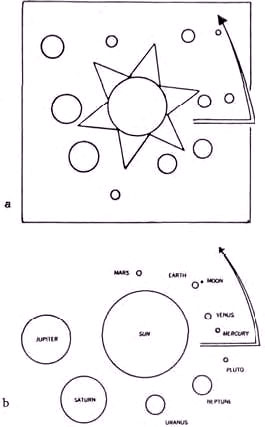
Fig. 6
The Sumerian depiction also reveals, however, some differences.
These are not artist’s errors or misinformation; on the contrary,
the differences—two of them—are very significant. The first
difference concerns Pluto. It has a very odd orbit—too inclined to
the common plane (called the Ecliptic) in which the planets orbit
the Sun, and so elliptical that Pluto sometimes (as at present and
until 1999) finds itself not farther but closer to the Sun than
Neptune. Astronomers have therefore speculated, ever since its
discovery in 1930, that Pluto was originally a satellite of another
planet; the usual assumption is that it was a moon of Neptune that
“somehow”—no one can figure out how—got torn away from its
attachment to Neptune and attained its independent (though bizarre)
orbit around the Sun.
This is confirmed by the ancient depiction, but with a significant
difference. In the Sumerian depiction Pluto is shown
not near Neptune but between Saturn and Uranus. And Sumerian
cosmological texts, with which we shall deal at length,
relate that Pluto was a satellite of Saturn that was let loose to
eventually attain its own “destiny”—its independent orbit around the
Sun.
The ancient explanation regarding the origin of Pluto reveals not
just factual knowledge but also great sophistication in matters
celestial. It involves an understanding of the complex forces that
have shaped the Solar System, as well as the development of astrophysical theories by which moons can become
planets or planets in the making can fail and remain moons. Pluto,
according to Sumerian cosmogony, made it; our Moon, which was in the
process of becoming an independent planet, was prevented by
celestial events from attaining the independent status.
Modern astronomers moved from speculation to the conviction that
such a process has indeed occurred in our Solar System only after
observations by the Pioneer and Voyager spacecraft determined in the
past decade that
Titan, the largest moon of Saturn, was a
planet-in-the-making whose detachment from Saturn was not completed.
The discoveries at Neptune reinforced the opposite speculation
regarding Triton, Neptune’s moon that is just 400 miles smaller in
diameter than Earth’s Moon. Its peculiar orbit, its volcanism, and
other unexpected features have suggested to the JPL scientists, in
the words of the Voyager project’s chief scientist Edward Stone,
that,
“Triton may have been an object sailing through the Solar
System several billion years ago when it strayed too close to
Neptune, came under its gravitational influence and started orbiting
the planet.”
How far is this hypothesis from the Sumerian notion that planetary
moons could become planets, shift celestial positions, or fail to
attain independent orbits? Indeed, as we continue to expound the
Sumerian cosmogony, it will become evident that not only is much of
modern discovery merely a rediscovery of ancient knowledge but that
ancient knowledge offered explanations for many phenomena that
modern science has yet to figure out.
Even at the outset, before the rest of the evidence in support of
this statement is presented, the question inevitably arises:
How on Earth could the Sumerians have known all that so long ago, at
the dawn of civilization?
The answer lies in the second difference between the Sumerian
depiction of the Solar System (Fig. 6a) and our present knowledge of
it (Fig. 6b). It is the inclusion of a large planet in the empty
space between Mars and Jupiter. We are not aware of any such planet;
but the Sumerian cosmological, astronomical, and historical texts
insist that there indeed exists one more planet in our Solar
System—its twelfth member: they included the
Sun, the Moon (which they counted as a celestial body in its own
right for reasons stated in the texts), and ten, not nine, planets.
It was the realization that a planet the Sumerian texts called
NIBIRU (“Planet of the Crossing”) was neither Mars nor Jupiter, as
some scholars have debated, but another planet that passes between
them every 3,600 years that gave rise to my first book’s title, The
12th Planet—the planet which is the “twelfth member” of the Solar
System (although technically it is, as a planet, only the tenth).
It was from that planet, the Sumerian texts repeatedly and
persistently stated, that
the ANUNNAKI came to Earth. The term
literally means “Those Who from Heaven to Earth Came.” They are
spoken of in the Bible as the Anakim, and in Chapter 6 of Genesis
are also called
Nefilim, which in Hebrew means the same thing:
Those
Who Have Come Down, from the Heavens to Earth.
And it was from the Anunnaki, the Sumerians explained—as though they
had anticipated our questions—that they had learnt all they knew.
The advanced knowledge we find in Sumerian texts is thus, in effect,
knowledge that was possessed by the Anunnaki who had come from Nibiru; and theirs must have been a very advanced civilization,
because as I have surmised from the Sumerian texts, the Anunnaki
came to Earth about 445,000 years ago. Way back then they could
already travel in space. Their vast elliptical orbit made a
loop—this is the exact translation of the Sumerian term—around all
the outer planets, acting as a moving observatory from which the
Anunnaki could investigate all those planets. No wonder that what we
are discovering now was already known in Sumerian times.
Why anyone would bother to come to this speck of matter we call
Earth, not by accident, not by chance, not once but repeatedly,
every 3,600 years, is a question the Sumerian texts have answered.
On their planet Nibiru, the Anunnaki/Nefilim were facing a situation
we on Earth may also soon face: ecological deterioration was making
life increasingly impossible. There was a need to protect their
dwindling atmosphere, and the only solution seemed to be to suspend
gold particles above it, as a shield. (Windows on American
spacecraft, for example, are coated with a thin layer of gold to
shield the astronauts from radiation).
This
rare metal had been discovered by the Anunnaki on what they called
the Seventh Planet (counting from the outside inward), and they
launched Mission Earth to obtain it. At first they tried to obtain
it effortlessly, from the waters of the Persian Gulf; but when that
failed, they embarked on toilsome mining operations in southeastern
Africa. Some 300,000 years ago, the Anunnaki assigned to the African
mines mutinied. It was then that the chief scientist and the chief
medical officer of the Anunnaki used genetic manipulation and
in-vitro fertilization techniques to create “primitive workers”—the
first Homo sapiens to take over the backbreaking toil in the gold
mines.
The Sumerian texts that describe all these events and their
condensed version in the Book of Genesis have been extensively dealt
with in The 12th Planet. The scientific aspects of those
developments and of the techniques employed by the Anunnaki are the
subject of this book. Modern science, it will be shown, is blazing
an amazing track of scientific advances—but the road to the future
is replete with signposts, knowledge, and advances from the past.
The Anunnaki, it will be shown, have been there before; and as the
relationship between them and the beings they had created changed,
as they decided to give Mankind civilization, they imparted to us
some of their knowledge and the ability to make our own scientific
advances.
Among the scientific advances that will be discussed in
the ensuing chapters will also be the mounting evidence for the
existence of Nibiru. If it were not for The 12th Planet, the
discovery of Nibiru would be a great event in astronomy but no more
significant for our daily lives than, say, the discovery in 1930 of
Pluto. It was nice to learn that the Solar System has one more
planet “out there,” and it would be equally gratifying to confirm
that the planetary count is not nine but ten; that would especially
please astrologers, who need twelve celestial bodies and not just
eleven for the twelve houses of the zodiac.
But after the publication of The 12th Planet and the evidence
therein—which has not been refuted since its first printing in
1976—and the evidence provided by scientific advances since then,
the discovery of Nibiru cannot remain just a matter involving
textbooks on astronomy. If what I have written is so— if, in other words, the Sumerians were correct
in what they were recording—the discovery of Nibiru would mean not
only that there is one more planet out there but that there is Life
out there. Moreover, it would confirm that there are intelligent
beings out there—people who were so advanced that, almost half a
million years ago, they could travel in space; people who were
coming and going between their planet and Earth every 3,600 years.
It is who is out there on Nibiru, and not just its existence, that
is bound to shake existing political, religious, social, economic,
and military orders on Earth. What will the repercussions be
when—not if—Nibiru is found?
It is a question, believe it or not, that is already being pondered.
GOLD MINING—HOW LONG AGO?
Is there evidence that mining took place, in southern Africa, during
the Old Stone Age? Archaeological studies indicate that it indeed
was so.
Realizing that sites of abandoned ancient mines may indicate where
gold could be found, South Africa’s leading mining corporation, the
Anglo-American Corporation, in the 1970s engaged archaeologists to
look for such ancient mines. Published reports (in the corporation’s
journal Optima) detail the discovery in Swaziland and other sites in
South Africa of extensive mining areas with shafts to depths of
fifty feet.
Stone objects and charcoal remains established dates of
35,000, 46,000, and 60,000 B.C. for these sites. The archaeologists
and anthropologists who joined in dating the finds believed that
mining technology was used in southern Africa “during much of the
period subsequent to 100,000 B.C.”
In September 1988, a team of international physicists came to South
Africa to verify the age of human habitats in Swaziland and
Zululand. The most modern techniques indicated an age of 80,000 to
115,000 years. Regarding the most ancient gold mines of Monotapa in
southern Zimbabwe, Zulu legends hold that they were worked by,
“artificially produced flesh and blood slaves created by the First
People.”
These slaves, the Zulu legends recount, “went into battle
with the Ape-Man” when “the great war star appeared in the sky” (see
Indaba My Children, by the Zulu medicine man
Credo Vusamazulu Mutwa).
Back to Contents
Back to Gold for Humans and Others...
|









